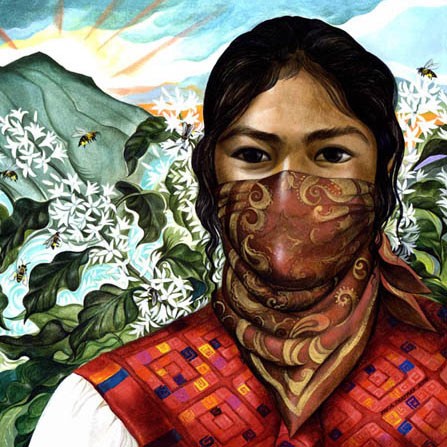Luis Hernández Navarro
Originally published in Spanish in La Jornada
Chiapas burns. The owners of the paramilitary groups taken them off the leash, and now emboldened, they operate with free reign. They have attacked indigenous rebel communities with firearms and indulged themselves, for example in Santa Martha, of parading around with weapons and uniforms and disarming agents of the state preventative police.
This past August 22nd, a group of passenger transport drivers from the town of Oxchuc who belong to the Regional Organization of Coffee Growers in Ocosingo (ORCAO, by its Spanish acronym) which is headed by Tomás Santiz Gómez, shot up, looted, and burned two coffee warehouses which belong to the bases of support of the Zapatista Army for National Liberation (EZLN) in the Cuxuljá community of the Moisés Gandhi rebel municipality (Ocosingo, by its official name).
Cuxuljá is a small town at the foot of the highway that connects San Cristóbal and Ocosingo. It is surrounded by eight autonomous Zapatista municipalities and sits at the intersection of various communities. It was occupied by the army until 2001 when the soldiers withdrew from their position in order to comply with the three demands that the EZLN made of Vicente Fox’s administration in order to restore dialogues [between the government and the EZLN].
The troop withdrawal did not “pacify” the zone. As soon as talks failed—due to congress passing a constitutional reform on indigenous rights and culture that breached the San Andrés Accords—the ORCAO paramilitary group began attacking the rebel bases in that community. Their goal was to occupy the territory that the troops had left.
The ORCAO wasn’t always like this. For a number of years it was closely related to Zapatismo. It broke this tie however between 1997 and 1999, and the leadership began to undermine its rebel social base by offering economic support and government posts to prominent figures within the organization. During the administration of Pablo Salazar as governor of the state (2000-2006) the conflict escalated, and in 2002, the coffee growers organization dramatically intensified their attacks against the Zapatista bases of support, including the destruction one of their murals. The ORCAO became a paramilitary force.
The ORCAO was formed in 1988 with 12 communities in Sibacjá, municipality of Ocosingo. Other towns soon joined them, totaling almost 90 communities. Their original demands were as much around the search for better coffee prices (which fell drastically in 1989) as they were for a solution to delayed land reform. Influenced by progressive pastoral work, in the context of the commemoration of 500 years of Indigenous, Black and Popular Resistance in 1992, it defended indigenous self-determination, opposed the constitutional reform of Article 27, and demanded liberty, justice, and democracy (https://bit.ly/3goUvWS).
Nevertheless, the group suffered a relentless decomposition. They were practically expelled from Unorca in 2015. Internally, two factions fought over its leadership: the group of José Pérez, linked to the partido verdeand to the control of passenger transport; and the group of Juan Vázquez, the commissioner for reconciliation in the Juan Sabines administration, oriented toward the production side of the organization. Allied with whichever administration was in power, their leaders have enjoyed positions in public administration for their own personal benefit. Many formed part of the PRD, the PVEM, and now the MORENA administrations.
ORCAO attacks against Cuxuljá have a long history. As a result of the armed uprising, a group of EZLN bases of support (a collective of 539 peasants) were granted 1,433 hectares expropriated from formerestate owners. They have a “Deed of Granting and Reception of Lands” from the Department of Agrarian Reform.
The Zapatistas work the land collectively and refuse to parcel it out individually, insisting that to do so would be like returning to 1994. However, a small group from the ORCAO who abandoned the community and sold their homes, with the support of the army and police, has insisted for the past 19 years on parceling out the property, titling the land, and selling individually what is the product of a common struggle.
The ORCAO’s attacks against the EZLN’s bases of support have been constant and are not limited to Cuxuljá but rather span several municipalities. The last one took place last February 23 in Chilón, when the ORCAO, the Chinchulines, and MORENA party members assaulted and kidnapped community representatives in retaliation for participating in the “Days in Defense of Territory and Mother Earth ‘We Are All Samir’” (https://bit.ly/3leg3cs).
These attacks have been carried out within the context of government offensives to try to weaken Zapatismo and stop its advance. They are not the product of inter-community squabbles, but rather the result of a state strategy to fabricate internal conflicts. The administrations in power (even the current one) support the ORCAO with economic resources, productive projects (many of them livestock projects), political backing, and police impunity to try to erode and wear down the EZLN.
Barely a year ago, the rebels announced the creation of seven new caracoles in addition to the five existing ones, giving them a total of 43 self-governing bodies with no relation to official government bodies. Additionally, they have announced their rejection of the “Mayan Train” and the “Interoceanic Corridor”. The new battle of Cuxuljá and the unstoppable war of the Chenalhó paramilitaries are part of a containment strategy against the advance of Zapatismo—a strategy that doesn’t seem concerned about setting the state on fire.
